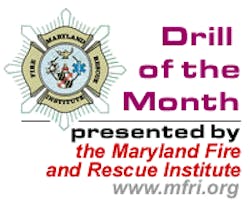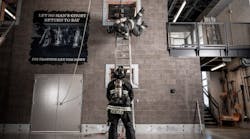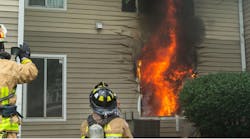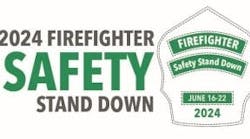EMS and Hazardous Materials Operations
Instructor Guide
Session Reference: 1
Level of Instruction:
Time Required: Two Hours
Materials:
• Audio-visual equipment to project any visuals
• 2000 Emergency Response Guidebook
References:
• Hazardous Materials Operations, Maryland Fire and Rescue Institute
• Emergency Care, Eighth Edition, Brady
• 2000 Emergency Response Guide, U.S. Department of Transportation
PREPARATION:
Motivation:
Objective (SPO): 1-1
The student will demonstrate a better understanding of hazardous materials emergencies and the roles and responsibilities of emergency medical services personnel at them.
Overview:
EMS and Hazardous Materials Operations
• Relationships
• Recognition and Identification
• Emergency Response Guidebook
• Roles and Responsibilities
Session 1 EMS and Hazardous Materials Operations
SPO 1-1 The student will demonstrate a better understanding of hazardous materials emergencies and the roles and responsibilities of emergency medical services personnel at them.
EO 1-1 Identify the relationship between a hazardous material emergency and the emergency medical services.
EO 1-2 Identify the presence of a hazardous material utilizing various means of recognition and identification.
EO 1-3 Demonstrate a basic knowledge of the U.S. Department of Transportation Emergency Response Guidebook and how to use it at a hazardous materials incident.
EO 1-4 Identify the duties that EMS personnel may be expected to perform at a hazardous materials incident.
This drill is designed to make emergency medical services personnel more aware of the potential that hazardous materials may be involved in any medical emergency to which they respond and the importance of recognizing the presence of a hazardous material so that they do not become victims. It is assumed that the emergency medical services personnel have the knowledge, skills, and equipment to provide the emergency medical care that may be required.
I. Relationships (1-1)
A. Training Guidelines in OSHA Regulations (29 CFR 1910.120q)
NOTE: Hazardous materials training is the only emergency response training that is required by
law.
1. First Responder Awareness Level
a. Recognize potential incident
b. Call for assistance and standby
c. Take no further action
d. Not part of emergency response
2. First Responder Operations Level
a. Defensive operations - outside release area
b. Damning, diking, decon assistance
c. Dispatched as part of initial response
3. Technician Level
a. Offensive operations
b. Perform duties if properly equipped, trained, protected, and with backup personnel
c. Usually member of hazmat team
4. Specialist Level
a. Enhanced or specialized training
5. Incident Commander Level
a. Trained to operations level
b. Background in ICS
B. Potential for Involvement
1. Responding to an EMS alarm where hazardous materials may cause the victim to become sick or
injured
a. Many hazardous materials emergencies are initially dispatched as a person down or person sick
b. EMS personnel may be in the area of immediate release before realizing it
c. Remember to make sure that the scene is safe
2. Attempted suicide
a. Carbon monoxide
b. Asphyxiation by gas - may also create an explosive atmosphere
3. Responding to a motor vehicle accident where one of the vehicles involved may be transporting
hazardous materials
a. Material may have released prior to arrival
b. Material may be releasing while approaching the scene
c. Material may release while patient care is being provided
4. Returning from an alarm and observing a hazardous materials release
5. Responding to a civil disturbance where hazardous materials may be used
a. Signs and symptoms may not be present upon arrival - delayed reaction
b. Potential for secondary release/device
II. Recognition and Identification (1-2)
Review the various means of recognizing and identifying the presence of a hazardous material
A. Containers
1. Shape and type
a. Tank - truck, train, fixed facility
b. Cylinder
c. Drum
d. Bag
e. Box
2. Material used
a. Metal - aluminum or steel
b. Glass
c. Paper or cardboard
d. Plastic
B. Markings
1. Placards - rail and road transportation only
a. Placards requirement on any quantity of poison gas, poison, explosives 1.1, explosives 1.2,
explosives 1.3, radioactives, and dangerous when wet products being transported
b. Placards only required for 1,000 lbs. or more of other products being transported
2. Labels - on packages or containers
3. Signage, stenciling
4. Color coding - not always reliable indicator
5. No marking requirement for fixed facilities
C. Occupancy
1. Known locations
2. Processes or activities
D. Senses
1. Sight - effects on
a. Humans
b. Animals
c. Plants
d. Form of material - solid, liquid, gas
e. Container damaged or stressed
f. Clouds
g. Runoff
2. Sound
a. Product being released under pressure
b. Relief valve operating
3. Smell - should not use to detect hazmat presence
E. Information from Others
1. Shipping papers
2. Occupant/bystander information
3. Dispatch information
III. Emergency Response Guidebook (1-3)
A. ERG Introduction
1. First produced in 1980
2. Updated every 3-4 years
3. First North American ERG produced in 1996 - joint effort with Canada and Mexico
4. Produced by the U. S. Department of Transportation
a. Information applicable to hazardous materials in transport
b. Produced as the result of an explosion at a construction site in Kansas City that killed several
firefighters
c. Designed to provide general information during the first 30 minutes of the incident
B. ERG Outline
NOTE: Have the students walk through the guidebook as you discuss each segment
1. Inside Cover
a. Important Shipping Paper Items
b. Placard Example
2. Basic guidelines
a. Resist rushing in
b. Approach from upwind
c. Stay clear of spills, vapors, fumes, smoke
3. Using guide for dangerous goods
a. Identify material
(1) Four-digit ID number on placard
(2) Four-digit number on package or shipping documents
(3) Product name on shipping document, package, or placard
b. Look up three-digit guide
C. Using the ERG
1. White pages
a. Safety precautions (page 6)
b. Placard charts (pages 15-17)
c. Rail/road identifications (pages 18-19)
d. Protective clothing (pages 364-365)
e. Chemical/biological agents (pages 368- 370)
2. Yellow-bordered pages
a. Numerical list
b. Highlighted products - indicates special isolation and evacuation information
c. Multiple products, same ID number
3. Blue bordered pages
a. Alphabetical list
b. Highlighted products - indicates special isolation and evacuation information
c. Correct spelling of product names - different products may have similar spellings but totally
different reactions
4. Orange bordered pages - guides 111-172
a. Potential hazards
(1) Health
(2) Fire/explosion
b. Public safety
(1) Protective clothing
(2) Evacuation
c. Emergency response
(1) Fire
(2) Spill or leak
(3) First aid
5. Green bordered pages
a. Isolation distances
b. Numeric order
c. Small spill/large spill
d. Day/night
e. Water reactive products
D. Exercises - have students look up information and share what they have found in the guide pages
1. Using yellow pages/orange pages/green pages
a. 1001 - acetylene, 116
b. 1005 - anhydrous ammonia, 125
c. 1013 - carbon dioxide,120
d. 1017 - chlorine, 124
e. 1072 - oxygen, 122
f. 1075 - LPG, 115
g. 1203 - gasoline, 128
h. 1993 - diesel fuel, 128
2. Using blue pages/orange pagers/green pages
a. Ammonium nitrate, 2071, 140
b. Hypochlorite solution, 1791, 154
c. Ethyl alcohol, 1170, 127
d. Trinitrotoluene, 1356, 113
e. Sulfuric acid, 1830, 137
f. Hydrogen peroxide, 2015, 143
g. Isopropyl alcohol, 1219, 129
h. Carbon monoxide, 1016, 119
IV. Roles and Responsibilities (1-4)
A. First on Scene
1. Review potential causes of harm
a. Thermal
(1) Flame contact
(2) Hot or cold exposure
b. Radiation
c. Asphyxiation
(1) Oxygen deficient environment
(2) Products that displace oxygen
d. Chemical
(1) Burns
(2) Reactions
e. Etiological
f. Mechanical
(1) Projectiles
(2) Sharp edges
(3) Unstable containers
2. May be willing to take risk and make quick rescue if required
3. Control access to scene and prevent entry
a. Keep all personnel a safe distance from the hazard and do not permit any operations to take
place which are beyond capabilities (training and equipment)
b. Maintain control over all emergency responders and civilians
4. Attempt to identify the product(s)
a. Identification numbers
b. Shipping papers
c. Placards, labels, or other markings
d. Container types or shape
e. Type of occupancy
f. Knowledgeable individual(s)
g. Pre-incident information
5. Make necessary notifications
a. Fire department
b. Law enforcement
c. Hazardous materials response personnel
d. Public works
e. Water and sewer - runoff
6. Establish operational zones
a. Hot Zone
(1) Area near release
(2) Perimeter determined initial isolation distances in Emergency Response Guidebook. May
also be determined or adjusted by detecting presence of product using detection devices
(3) May require specialized clothing and training
(a) Level A - vapor and splash protection with SCBA
(b) Level B - splash protection with SCBA
(c) Level C - splash protection with filter respirator
(d) Level D - work clothing
(4) Only entry personnel permitted
(5) Size and shape of zone can change with ambient temperature, wind, and hazard
b. Warm Zone
(1) Area next hot zone
(2) Area used for contamination reduction - size dependent on space needed
(3) May require specialized clothing – one level below clothing worn in hot zone
(4) Decontamination and backup personnel only permitted
c. Cold Zone
(1) Outside warm zone
(2) Area used for staging, incident command, medical support, and apparatus
(3) No special clothing required
B. Part of the Initial Response
1. Remain in the cold zone
2. Be prepared to receive patients
a. Decontamination may be limited to emergency measures such as washing down with booster
line and/or clothing removal
b. If decontamination is in place and being operated, patients should be decontaminated prior to
receipt
3. Take necessary measures to reduce contamination to personnel, equipment, and vehicle
a. Place victim in contamination control environment (body bag)
b. Provide personnel with necessary personal protective clothing based on universal precautions
c. May require removal of equipment and supplies not needed at that time
C. Operating with a hazardous materials team
1. Process personnel through medical evaluation - generally required for anyone donning chemical
protective clothing
2. Process personnel through medical evaluation upon completion of assigned decontamination duties
3. Prepare to receive decontaminated victims
4. Prepare to receive injured or exposed team members after emergency decontamination
5. Isolation of victim until transported or evaluated and released
6. May require isolation at treatment facility
At this time, you may want to review the following emergency care skills that may be needed on the scene of a hazardous materials emergency:
1. Burn treatment for thermal or chemical burns
2. Frostbite treatment for exposure to cold products
3. Respiratory therapy for products that have been inhaled or absorbed
4. Poison treatment for products that may have been ingested
5. Signs and symptoms for exposure to chemical or biological exposure
6. Treatment for lacerations and punctures from projectiles or sharp edges
You may also want to review the protective clothing that is available to your EMS providers, the protection it offers, and how and when it should be used. If self-contained breathing apparatus are carried on your ambulance or available to your EMS providers, you may want to review the operation of those units. A separate training exercise should be conducted to provide time for everyone to demonstrate their knowledge and skills with the SCBA.
SUMMARY:
Review:
EMS and Hazardous Materials Operations
• Relationships
• Recognition and Identification
• Emergency Response Guidebook
• Roles and Responsibilities
Remotivation:
Remember, one of the first things that is addressed in emergency care training is to make sure that the scene is safe so that you do not become a victim. Look as you approach the scene and look at the whole scene as you get closer. Focusing on the patient rather than scene safety can have temporary or permanent results.






